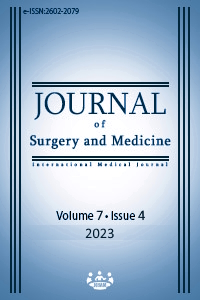The effect of minimal and high flow anesthesia on optic nerve sheath diameter in laparotomic gynecological surgery
Anesthesia on optic nerve sheath diameter
Keywords:
minimal flow anesthesia, high flow anesthesia, ultrasonography, optic nerve sheath diameter, gynecological surgeryAbstract
Background/Aim: Optic nerve sheath diameter (ONSD) is a surrogate parameter for intracranial pressure. This study evaluated the effect of anesthetics on ONSD in women undergoing surgery. We aimed to measure the effect of minimal and high flow anesthesia techniques on expiratory/inspiratory oxygen and carbon dioxide fraction values, hemodynamic parameters, and the optic nerve sheath diameter by ultrasonography in open gynecological surgeries.
Methods: In the present prospective cohort study, 80 patients who planned laparotomic gynecological surgery were divided into two groups: a high flow of 2 L/min and a minimum flow of 0.5 L/min. Anesthesia was maintained with 50% oxygen-50% air at 2 L/min and desflurane at 1.1 MAC in Group 1 (n=40) and 50% oxygen-50% air at 0.5 L/min and desflurane at 1.1 MAC in Group 2 (n=40). After 10–15 min, group 2 was administered minimal flow with 50–60% oxygen and 40–50% air at 0.5 L/min desflurane, and 10 min before the end of the surgery, the patients were switched to high flow with 50% oxygen-50% air at 2 L/min.
Results: Decreasing heart rates were higher in Group 2 (T0 P=0.001, T2 P=0.007, T3 P=0.035). There was a significant positive correlation between EtCO2 at the 60th min and optic nerve sheath diameter measurements in the minimal flow group (left ONSD r=0.440, P=0.004, right ONSD r=0.473, P=0.002). Although inspiratory oxygen values in Group 2 did not fall below 32%, it was lower than Group 1 except for the last measurement time.
Conclusion: Minimal flow anesthesia is as safe as high flow in terms of effects on optic nerve sheath diameter and oxygenation parameters in laparotomic gynecological surgery.
Downloads
References
Akeju O, Brown EN. Neural oscillations demonstrate that general anaesthesia and sedative states are neurophysiologically distinct from sleep. Current opinion in neurobiology. 2017;44:178-85. DOI: https://doi.org/10.1016/j.conb.2017.04.011
George Mychaskiw I. Low and minimal flow anesthesia: Angels dancing on the point of a needle. Journal of Anaesthesiology, Clinical Pharmacology. 2012;28(4):423. DOI: https://doi.org/10.4103/0970-9185.101883
Baum J, Aitkenhead A. Low‐flow anaesthesia. Anaesthesia. 1995;50:37-44. DOI: https://doi.org/10.1111/j.1365-2044.1995.tb06189.x
Fan S-Z, Lin Y-W, Chang W-S, Tang C-S. An evaluation of the contributions by fresh gas flow rate, carbon dioxide concentration and desflurane partial pressure to carbon monoxide concentration during low fresh gas flows to a circle anaesthetic breathing system. European journal of anaesthesiology. 2008;25(8):620-6. DOI: https://doi.org/10.1017/S0265021508003918
Baum JA. Low-flow anaesthesia: theory, practice, technical preconditions, advantages, and foreign gas accumulation. Journal of Anaesthesia. 1999;13(3):166-74. DOI: https://doi.org/10.1007/s005400050050
Park SY, Chung CJ, Jang JH, Bae JY, Choi SR. The safety and efficacy of minimal-flow desflurane anaesthesia during prolonged laparoscopic surgery. Korean Journal of Anesthesiology. 2012;63(6):498-503. DOI: https://doi.org/10.4097/kjae.2012.63.6.498
Debre Ö, Sarıtaş A, Şentürk Y. Influence of sevoflurane on hemodynamic parameters in low flow anaesthesia applied without nitrous oxide. J Clin Exp Invest. 2014;5(1). DOI: https://doi.org/10.5799/ahinjs.01.2014.01.0351
Colak YZ, Toprak HI. Feasibility, safety, and economic consequences of using low flow anaesthesia according to body weight. Journal of anaesthesia. 2020;34(4):537-42. DOI: https://doi.org/10.1007/s00540-020-02782-y
Baum J. Low-flow anaesthesia. LWW; 1996. p. 432-5. DOI: https://doi.org/10.1097/00003643-199609000-00002
Kupisiak J, Goch R, Polenceusz W, Szyca R, Leksowski K. Bispectral index and cerebral oximetry in low-flow and high-flow rate anaesthesia during laparoscopic cholecystectomy–a randomized controlled trial. Videosurgery and Other Miniinvasive Techniques. 2011;6(4):226-30. DOI: https://doi.org/10.5114/wiitm.2011.26256
Tokgöz N, Ayhan B, Saricaoglu F, Akinci SB, Aypar Ü. A comparison of low and high flow desflurane anaesthesia in children. Turkish Journal of Anaesthesiology & Reanimation. 2012;40(6):303. DOI: https://doi.org/10.5152/TJAR.2012.011
Vaiman M, Abuita R, Bekerman I. Optic nerve sheath diameters in healthy adults measured by computer tomography. International journal of ophthalmology. 2015;8(6):1240.
Strapazzon G, Brugger H, Dal Cappello T, Procter E, Hofer G, Lochner P. Factors associated with optic nerve sheath diameter during exposure to hypobaric hypoxia. Neurology. 2014;82(21):1914-8. DOI: https://doi.org/10.1212/WNL.0000000000000457
Dinsmore M, Han J, Fisher J, Chan V, Venkatraghavan L. Effects of acute controlled changes in end‐tidal carbon dioxide on the diameter of the optic nerve sheath: a transorbital ultrasonographic study in healthy volunteers. Anaesthesia. 2017;72(5):618-23. DOI: https://doi.org/10.1111/anae.13784
Newman W, Hollman A, Dutton G, Carachi R. Measurement of optic nerve sheath diameter by ultrasound: a means of detecting acute raised intracranial pressure in hydrocephalus. British journal of ophthalmology. 2002;86(10):1109-13. DOI: https://doi.org/10.1136/bjo.86.10.1109
Robba C, Santori G, Czosnyka M, Corradi F, Bragazzi N, Padayachy L, et al. Optic nerve sheath diameter measured sonographically as non-invasive estimator of intracranial pressure: a systematic review and meta-analysis. Intensive care medicine. 2018;44(8):1284-94. DOI: https://doi.org/10.1007/s00134-018-5305-7
Mondillo S, Galderisi M, Mele D, Cameli M, Lomoriello VS, Zacà V, et al. Speckle‐tracking echocardiography: a new technique for assessing myocardial function. Journal of Ultrasound in Medicine. 2011;30(1):71-83. DOI: https://doi.org/10.7863/jum.2011.30.1.71
Blaivas M, Theodoro D, Sierzenski PR. Elevated intracranial pressure detected by bedside emergency ultrasonography of the optic nerve sheath. Academic emergency medicine. 2003;10(4):376-81. DOI: https://doi.org/10.1111/j.1553-2712.2003.tb01352.x
Yunos NaM, Bellomo R, Glassford N, Sutcliffe H, Lam Q, Bailey M. Chloride-liberal vs. chloride-restrictive intravenous fluid administration and acute kidney injury: an extended analysis. Intensive care medicine. 2015;41(2):257-64. DOI: https://doi.org/10.1007/s00134-014-3593-0
Downloads
- 468 755
Published
Issue
Section
How to Cite
License
Copyright (c) 2023 Anıl Onur, Tuğba Onur, Ümran Karaca, H Erkan Sayan, Canan Yılmaz, Nermin Kılıçarslan
This work is licensed under a Creative Commons Attribution-NonCommercial-NoDerivatives 4.0 International License.
















